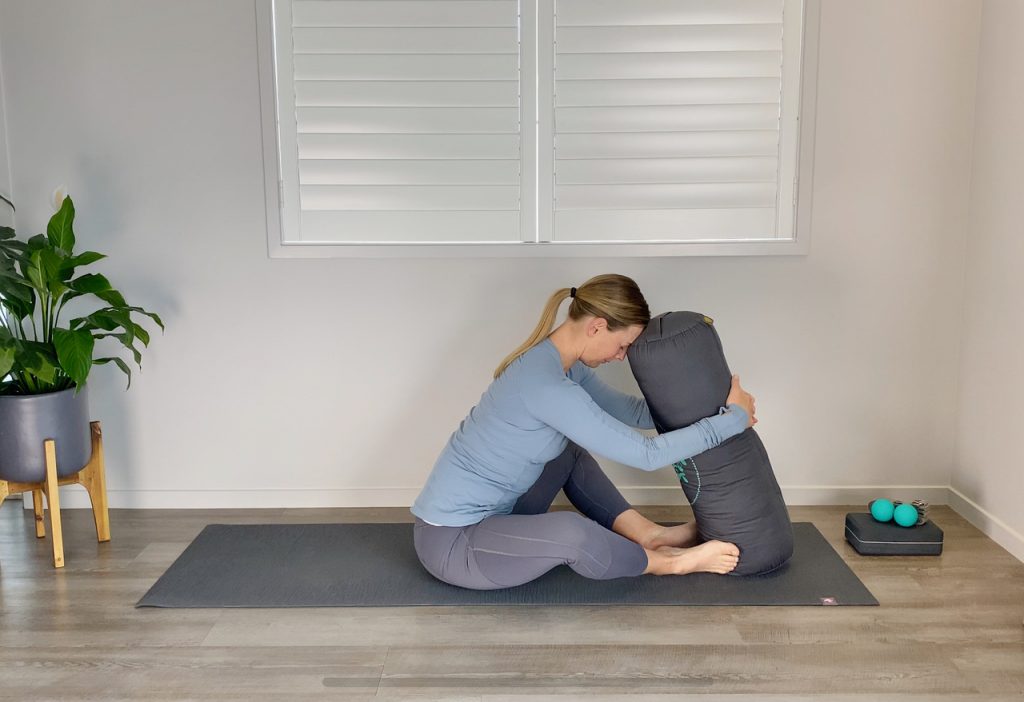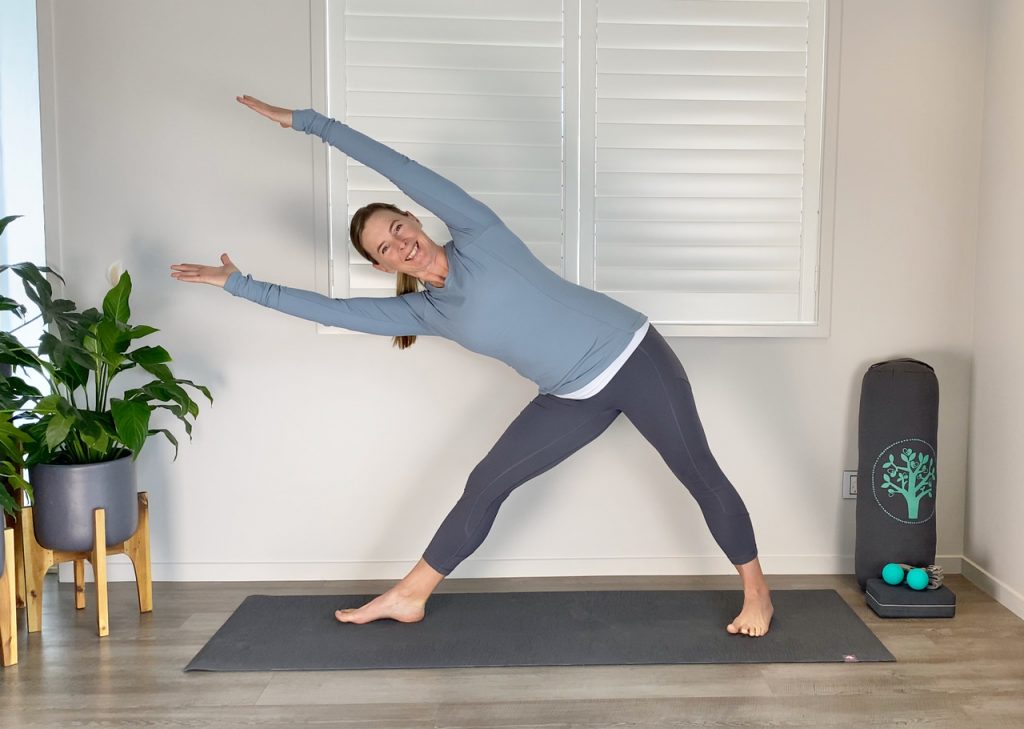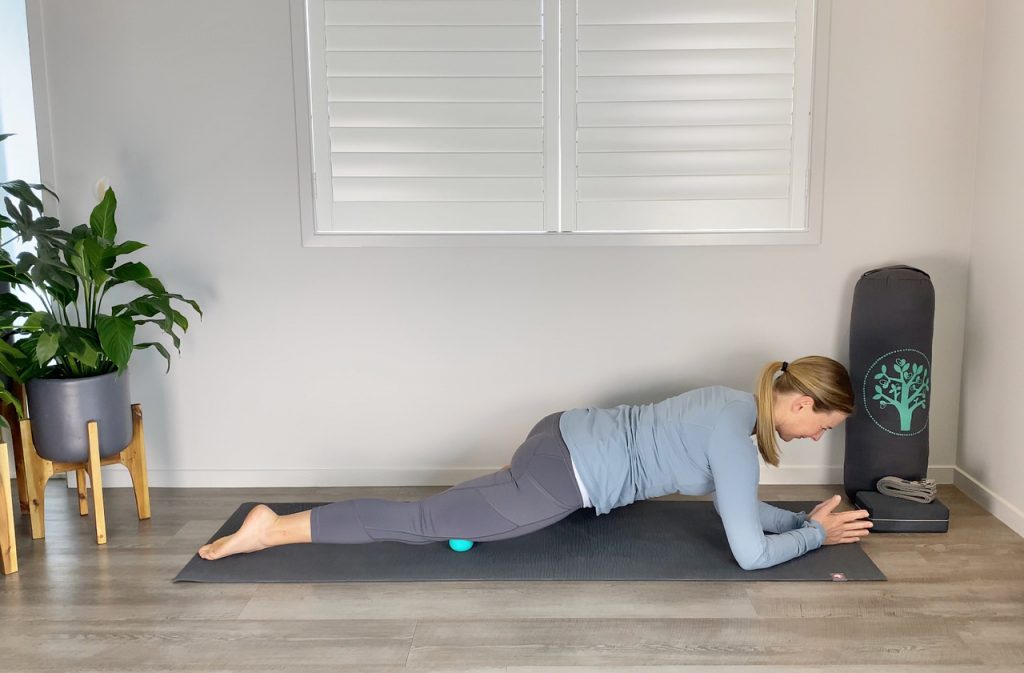Articles, In the Press, Myofascial Release, Rachel Land, Resources, Yoga Medicine® News
4 Ways a Varied Yoga Practice Supports Healthy Fascia
By Rachel Land, Senior Yoga Medicine® teacher, for Yoga Digest.
Many of us, myself included, practice yoga asana with the aim of improving or maintaining well-rounded good health. One of the key physical impacts of yoga practice is on our connective tissue, or fascia.
Fascia plays several vital roles in supporting our health. It connects and coordinates our various body structures into a coordinated whole, and allows for movement between them. It transmits force from one part of the body to others, and creates both strength and adaptability. It cushions and protects internal structures like blood vessels and nerves, and contains key immune cells. It contains more nerves than any other bodily structure other than the skin, providing our central nervous system with a rich tapestry of information about our bodies and the environment around us.
Yoga is principally experiential, rather than theoretical, and regardless of what style we practice or what level of experience we have, we almost always feel better after class. However it’s nice to know that science backs up this experience: research suggests that a varied asana practice offers several key benefits to our fascia, and thereby to our overall wellbeing.
Whole-Body Movement
Improved mobility, increased proprioception, and decreased perceived pain.
There’s no doubt our bodies are made to move; simply getting out of the car after a long road trip is enough to remind us of that. That’s why we hear sayings like “move it or lose it” and “motion is lotion”. And they’re not wrong: varied movement not only feels good, but is also good for us.
The first reason is the thixotropic effect. Our fascia varies in viscosity depending how much movement it is exposed to. When we are static for long periods, such as overnight or during that long road trip, it becomes more solid; when we move, it becomes more gel-like. This quality is called thixotropy. The implication for asana practice is that simply taking our bodies into various shapes across multiple planes—changing the state of our fascia from sol to gel—allows for freer and easier movement.
The second reason is the information it feeds our proprioceptive sensors. As we move, we send a constant stream of information to nerves in the fascia of our tendons and joint capsules. These nerves relay detailed information to our nervous system on where we are positioned in space, a sense called proprioception. By providing those nerves with more varied information we hone our proprioceptive sense, training ourselves to move with more sureness and grace.
Interestingly, research (1) suggests that proprioceptive inputs and nociceptive (threat or pain) inputs compete for the same nervous system pathways, implying that improved proprioception could also reduce perceived pain.
The implications for yoga practice are clear: moving our bodies through different planes of motion and in orientations to gravity can have wide-reaching benefits. So experiment with different poses and variations, teachers and practice styles. Play with your pace and intensity. Build your proprioceptive sense by practicing on different surfaces, moving your gaze point or drishti or even closing your eyes.
Gentle Long-Held Stretches
Long-lasting hydration and an anti-inflammatory effect
Hydration is key to fascial health. Firstly, fluid allows for glide between tissue layers, facilitating free movement between neighboring structures. Secondly, fluid makes our fascia stronger by creating pressure from the inside out; to understand how that occurs, visualize a plant drooping before watering and springing up after it.
Long-lasting but low intensity poses, like those we practice in Yin Yoga, offer a helpful boost to fascial hydration. These poses act on our fascia that same way that squeezing a sponge creates space for it to refill with fresh fluid. Subjecting our fascia to sustained tension—whether by lengthening, compressing or twisting—briefly drives fluid out, and this process prompts a hydration rebound that continues for hours after the tension has been released and results in higher than pre-stretch fluid levels (2) .
As a bonus, recent research also suggests an intriguing link between long duration, low- intensity stretching (10 minutes twice a day) and decreased inflammation (3). So incorporate some long, gentle stretches in your asana practice. Rather than looking for strong sensation, enjoy feeling the more subtle influence of tension—lengthening, compressing and twisting your fascia in varied directions to generate a nourishing rebound in hydration.
Eccentric Loading
Enhanced collagen synthesis.
Fluid is the largest component of our fascia, and a key source of its strength; collagen is another. Collagen fibers are the scaffolding of our soft tissues and are laid down, or synthesized, to repair tissue after damage, or in response to load. Areas of our body that are exposed to higher load (such as body weight, gravity or impact) experience higher collagen synthesis, and moreover the collagen fibres are laid down in the direction of the load.
Yoga isn’t all about moving and stretching; there can be a significant strength aspect as well. The specific kind of strength work that seems to best stimulate collagen production is eccentric strength work – where we activate a muscle in its lengthened position (4). This kind of muscle engagement stimulates orderly collagen production, making the fascia in that area stronger or faster to repair.
In yoga practice, these opportunities abound. You’ve felt eccentric muscle engagement in the triceps on the backs of your arms as you lower from plank to chaturanga, in the quads on the fronts of your thighs as you bend your knees from tadasana into chair or fierce pose, in the hamstrings on the backs of your thighs as you hinge from tadasana into uttanasana, or in the top side of your body in extended side angle or triangle pose.
Seek out these poses and variations in your practice. Look for opportunities to engage your tissues as they lengthen, then maximize the benefits by lingering there for an extra breath or two. That challenge will encourage the fascia to adapt, boosting collagen production in the direction of load and making your fascia stronger and more resilient.
Self Myofascial Release
Overall fascia health, including rehydration and glide between tissue layers.
Our muscles are connected, surrounded, and interpenetrated with a network of fascia—hence the term myofascia. Myofascial release is any technique that stretches, squeezes, or sheers our myofascia; self-myofascial release often involves using body weight on a foam roller, tennis ball, yoga block or other tool to create that therapeutic compression.
Now that you know that fascia benefits from twisting and compression as much as it does from stretching, it’s easy to understand how self-myofascial release can be a helpful adjunct to more traditional asana practices. Chief benefits are improved hydration and collagen synthesis, and maintenance of healthy movement between muscle layers. It can also offer novel stimulus to the nervous system, helping us recognize and release patterns of tension as well as improving proprioception.
So, while traditional yoga poses offer far-reaching benefits to our fascia, we can also benefit from branching out. Incorporating targeted pressure from a foam roller, massage balls or a soft yoga block could be exactly the boost our fascia needs to keep us healthy and feeling good.
Our physical health is not the only reason to commit to regular yoga practice, but for many of us it is a significant factor. Humans have felt the benefits of a physical practice for generations, and science is now helping us understand why. The key takeaway from current research is that we reap the most benefits from a varied and well-rounded yoga practices.
Other References:
- Effects on c-Fos expression in the PAG and thalamus by selective input via tetrodotoxin-resistant afferent fibers from muscle and skin. Soghra Gholami, Daniela Lambertz, Ulrich Hoheisel, Siegfried Mense. Journal of Neuroscience Research (2006). https://pubmed.ncbi.nlm.nih.gov/16962193/.
- Strain Hardening of Fascia: Static stretching of dense fibrous connective tissues can induce a temporary stiffness increase accompanied by enhanced matrix hydration. Robert Schleip PhD MA, Lutz Duerselen PhD, Andry Vleeming PhD, Ian L. Naylor PhD, Frank Lehmann-Horn MD PhD, Adjo Zorn PhD, Heike Jaeger PhD, Werner Klingler MD. Journal of Bodywork Therapy Journal of Bodywork & Movement Therapies (2012). https://pubmed.ncbi.nlm.nih.gov/22196433/.
- Stretching of the back improves gait, mechanical sensitivity and connective tissue inflammation in a rodent model. Sarah M Corey, Margaret A Vizzard, Nicole A Bouffard, Gary J Badger, Helene M Langevin. Plos ONE (2012). https://pubmed.ncbi.nlm.nih.gov/22238664/.
- Effect of eccentric training on the plantar flexor muscle-tendon tissue properties. Nele Nathalie Mahieu, Peter McNair, Ann Cools, Caroline D’Haen, Katrien Vandermeulen, Erik Witvrouw. Medicine & Science in Sports & Exercise (2008). https://pubmed.ncbi.nlm.nih.gov/18091014/.
- Effects of yoga on chronic neck pain: A systematic review and meta-analysis. Holger Cramer, Petra Klose, Benno Brinkhaus, Andreas Michalsen, Gustav Dobos. Clinical Rehabilitation (2017). https://pubmed.ncbi.nlm.nih.gov/29050510/.
- I can’t find it! Distorted body image and tactile dysfunction in patients with chronic back pain. G Lorimer Moseley. Pain (2008). https://pubmed.ncbi.nlm.nih.gov/18786763/.
- Is there a relationship between lumbar proprioception and low back pain? A systematic review with Meta-Analysis. Matthew Hoyan Tong, Seyed Javad Mousavi, Henri Kiers, Paulo Ferreira, Kathryn Refshauge, Jaap van Dieën. Archives of Physical Medicine and Rehabilitation (2017). https://pubmed.ncbi.nlm.nih.gov/27317866/.
- Superior short-term results with eccentric calf muscle training compared to concentric training in a randomized prospective multi-center study on patients with chronic Achilles tendinosis. N Mafi, R Lorentzon, H Alfredson. Knee Surgery, Sports Traumatology, Arthroscopy (2001). https://pubmed.ncbi.nlm.nih.gov/11269583/.
- The role and implementation of eccentric training in athletic rehabilitation: tendinopathy, hamstring strains, and ACL reconstruction. Daniel Lorenz, Michael Reiman. International Journal of Sports Physical Therapy (2011). https://pubmed.ncbi.nlm.nih.gov/21655455/.
- Yoga for chronic low back pain: a meta-analysis of randomised controlled trials. Susan Holtzman, R Thomas Beggs. Pain Research and Management (2013). https://pubmed.ncbi.nlm.nih.gov/23894731/
















